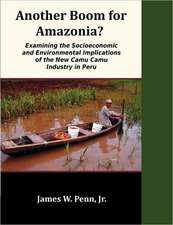Global Food Futures: Feeding the World in 2050
Autor Brian Gardneren Limba Engleză Hardback – 31 iul 2013
| Toate formatele și edițiile | Preț | Express |
|---|---|---|
| Paperback (1) | 227.34 lei 3-5 săpt. | |
| Bloomsbury Publishing – 31 iul 2013 | 227.34 lei 3-5 săpt. | |
| Hardback (1) | 776.65 lei 6-8 săpt. | |
| Bloomsbury Publishing – 31 iul 2013 | 776.65 lei 6-8 săpt. |
Preț: 776.65 lei
Preț vechi: 992.13 lei
-22% Nou
Puncte Express: 1165
Preț estimativ în valută:
148.63€ • 154.60$ • 122.70£
148.63€ • 154.60$ • 122.70£
Carte tipărită la comandă
Livrare economică 14-28 aprilie
Preluare comenzi: 021 569.72.76
Specificații
ISBN-13: 9780857851543
ISBN-10: 0857851543
Pagini: 272
Ilustrații: 21 bw illus
Dimensiuni: 189 x 246 x 20 mm
Greutate: 0.68 kg
Ediția:New.
Editura: Bloomsbury Publishing
Colecția Bloomsbury Academic
Locul publicării:London, United Kingdom
ISBN-10: 0857851543
Pagini: 272
Ilustrații: 21 bw illus
Dimensiuni: 189 x 246 x 20 mm
Greutate: 0.68 kg
Ediția:New.
Editura: Bloomsbury Publishing
Colecția Bloomsbury Academic
Locul publicării:London, United Kingdom
Caracteristici
This book is intended as an antidote to the highly polemical texts of recent times, offering a rational analysis of the factors which are likely to determine future food supply, demand and security
Notă biografică
Brian Gardner has been analysing, writing about and commenting on European and international agriculture and food policy developments for more than thirty years. Notable publications include European Agriculture: Policies, Production and Trade, Growing Pains: New Europe and the CAP in The Perfect Union? New Europe and the EU (edited by Roger Gough) and A Guide to the Reformed CAP.
Cuprins
IntroductionFamine or Plenty?World Agricultural TradeSpeculation and Food PricesThe Pattern of Food ConsumptionPopulation Growth and the Demand for FoodThe Production ResponseEnergy Supply and Food ProductionClimate Change and Food SupplyWorld Economy and the Demand for FoodThe Increasing Demand for FoodAccess to FoodSustainability of World Food ProductionConclusion - Apocalypse When?BibliographyIndex
Recenzii
A phenomenally important book. It pulls together the data to show whether or not agriculture can meet hungry populations in both the short and longer term future.
In Global Food Futures, Brian Gardner sets out to present a scholarly, balanced approach to the contentious area of food production and supply up to 2050. This text aims to tackle the global food situation in all its totality, from agricultural production, technological advance, dietary concerns, population changes, income trends, environmental issues, government food and agriculture policy, trade, financial markets, macroeconomics and food security. This book introduces the reader to a vast range of inter-disciplinary material to assess the development of future food demand and supply and global food production.
Global Food Futures is very readable and provides a comprehensive introduction to the wider concerns surrounding agriculture and our ability to feed ourselves in the future.
In Global Food Futures, Brian Gardner sets out to present a scholarly, balanced approach to the contentious area of food production and supply up to 2050. This text aims to tackle the global food situation in all its totality, from agricultural production, technological advance, dietary concerns, population changes, income trends, environmental issues, government food and agriculture policy, trade, financial markets, macroeconomics and food security. This book introduces the reader to a vast range of inter-disciplinary material to assess the development of future food demand and supply and global food production.
Global Food Futures is very readable and provides a comprehensive introduction to the wider concerns surrounding agriculture and our ability to feed ourselves in the future.
Descriere
By 2050 the world will face the enormous challenge of feeding 9 billion people in the face of climate change, rising energy costs and pressure on food-growing land and resources. This is the first scholarly yet accessible account of the global food situation, synthesising the key issues in one volume.






















